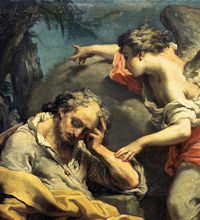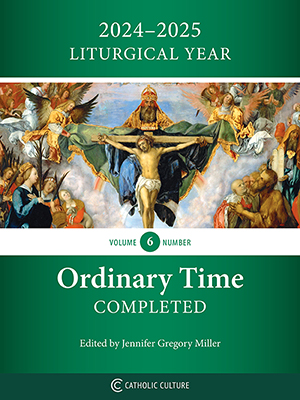» Enjoy our Liturgical Seasons series of e-books!
Today the Church celebrates the Fourth Sunday of Advent. We light the last candle on our Advent wreath and our preparation for Christmas is almost finished. We also reach the culmination of the O Antiphons. In previous antiphons our cry was directed to the Messiah as He manifested Himself to the Chosen People, to the Gentiles, and in nature; now He is addressed in person and asked to remain with us as Emmanuel.
Reading this final antiphon gives the feeling that a climax has indeed come. The very term Emmanuel, God with us, reveals the kindly, human heart of Jesus — He wants to be one of us, a Child of man, with all our human weakness and suffering; He wants to experience how hard it is to be man. He wants to remain with us to the end of time, He wants to dwell within us, He wants to make us share His nature.
Click here for commentary on the readings in the Extraordinary Form of the Roman Rite.
Sunday Readings
The first reading is taken from the Prophecy of Micah 5:1-4. In today's reading we hear words of hope that focus on one who is to be born in Bethlehem and who will bring in the day of peace when all nations will look to Jerusalem.
The second reading is taken from Hebrews 10:5-10. The perfect offering of Christ restores us to oneness with God. Jesus came to do the will of God perfectly. He overcame the power of evil that separates us from God and became our bridge back to God when we fall into evil. David prefigures Christ's sacrifice. The Psalm is now seen from the perspective of Christ.
The Gospel of this Sunday, Luke 1:38-45 recounts the visit of Mary to St. Elizabeth. An ancient title of Mary is Ark of the Covenant. The Church Fathers saw the parallels between the Old Testament wooden chest containing the divine presence and the Virgin about to give birth to Jesus. This theme is developed in a tape series by Tim Staples. Tim brings out the similarities between today's Gospel and the ascent of the Ark to Jerusalem (2 Sam 6:1-15).
1. As the ark is brought to Jerusalem, King David is overcome with awe saying, "How can the ark of the Lord come to me?" (v. 9)
2. The ark remains three months in the hill country near Jerusalem, bringing great blessings to the house of Obed-edom. (v.11)
3. King David leaps for joy -- dancing before the ark. (v. 13) (Tim Staples, All Generations Shall Call Me Blessed)
In today's Gospel, Elizabeth says to Mary, "Who am I that the Mother of my Lord should come to me?" She tells how the babe (John the Baptist) leaped in her womb as she became filled with the Holy Spirit. Finally Mary remains three months with her kinswoman before returning to her home. This Sunday, so close to Christmas, the Church invites us to focus our attention on Mary, round-wombed because of the God-child. As we say in the Litany of the Blessed Virgin: "Ark of the Covenant, pray for us."
Excerpted from Fr. Phil Bloom
O Emmanuel
Thou art He "who didst appear to Moses in the burning bush." "I have seen the affliction of My people in Egypt, and I have heard their cry because of the rigor of them that are over the works. And knowing their sorrow, I am come down to deliver them out of the hands of the Egyptians and to bring them out of that land into a good and spacious land, into a land that floweth with milk and honey" (Exod. 3:7 f.). Thus spoke the Lord to Moses from the bush which burned but was not consumed, which is a figure of God's condescension to assume the weakness of human nature. The human nature of Christ is united to the burning divine nature, and yet it is not consumed.
As Moses approached the burning bush, so we approach the divine Savior in the form of a child in the crib, or in the form of the consecrated host, and falling down we adore Him. "Put off the shoes from thy feet, for the place whereon thou standest is holy ground. . . . I am who am" (Exod. 3:5, 14).
O Adonai, almighty God! Mighty in the weakness of a child, and in the helplessness of the Crucified! Thou, almighty God, mighty in the wonders that Thou hast worked! Mighty in guiding, sustaining, and developing Thy Church! "The gates of hell shall not prevail against it" (Matt. 16:18).
"Come with an outstretched arm to redeem us." This is the cry of the Church for the second coming of Christ on the last day. The return of the Savior brings us plentiful redemption. "Come, ye blessed of My Father, possess you the kingdom prepared for you" (Matt. 25-34).
Excerpted from The Light of the World by Benedict Baur, O.S.B.
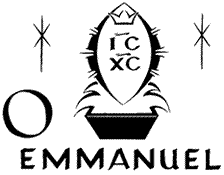 7th O Antiphon:
7th O Antiphon:
Our King and law-giver,
The awaited of the peoples,
And their Savior,
COME
To save us,
O Lord our God.
![]() Today is Day Eight of the Christmas Novena.
Today is Day Eight of the Christmas Novena.
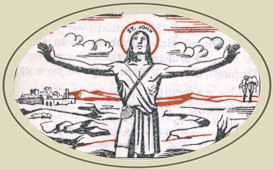 Commentary for the Readings in the Extraordinary Form:
Commentary for the Readings in the Extraordinary Form:
Fourth Sunday of Advent
"John, the son of Zachary," to a world now awaiting its God, pleads for our final pre-Christmas "make ready." "Make ready the way of the Lord, make straight His paths" (Gospel).
Heroically, in the desert, he warns against the softness of life in the city, pictured in the background. Alive to the danger of a "soft garments" life, he is seen in a rough "garment of camel hair," carrying a baptismal shell, "preaching a baptism of repentance."
Excerpted from My Sunday Missal, Confraternity of the Precious Blood
Advent Reflection: The Light of a New Humanity
Anyone who goes through our streets in the early days of December will often meet him, Santa Claus, dressed more or less as a bishop and never without his long white beard (which has been attributed to him since at least the eighth century). What these Santa Claus figures say and do is also more or less episcopal in nature; often they are more in the role of the bogeyman than of one who makes present the love of the Holy One, that love of which the legend speaks in many variations. It is almost impossible to tell with historical precision who this man was; and yet, by listening attentively to the oldest sources, through the mists of time, we can still discern the radiance of a figure who opens up a door to Advent, who can mediate, that is, an to of Jesus Christ.
In his portrayal of the life of St. Nicholas, his most ancient biographer, a certain Archimandrite Michael, says that Nicholas received is dignity from Christ's own sublime nature just as the morning star receives its brilliance from the rising sun. Nicholas was a living imitation of Christ: "In the radiance of his virtues", says the biographer, "the sun's righteousness has dawned." Tradition has always equated Santa Claus with the Bishop Nicholas who participated in the Council of Nicaea and, together with that first great assembly of bishops, helped to formulate the affirmation of the true divinity of Jesus Christ. What was at stake here was the core of Christianity, whether Christianity was to become just another sect or something really new, faith in the Incarnation of God himself. Was Jesus of Nazareth only a great religious man, or had God himself actually become, in him, one of us? So, ultimately, the question was this: Is God so mighty that he can make himself small; is he so mighty that he can love us and really enter our lives? For if God is too far away from us to love us effectively, then human love too is only an empty promise. If God cannot love, how can man be expected to do so? In professing faith in God's Incarnation, therefore, it was ultimately a case of affirming also man's capacity to live and die in a human manner. The figure of St. Nicholas, Santa Claus, illustrates and symbolizes this connection.
Theodor Schnitzler put this very well: "In putting his signature, in faith, to the mysterium of the incarnate Son of God, a person is enabled to be a helper of his fellow men, to bring happiness to children, families and the oppressed. Faith in the Incarnation promotes the salvation of mankind and the implementation of human rights."
The oldest sources concerning St. Nicholas also point in the same direction from a different angle: Nicholas is one of the first people of to be venerated as a saint without having been a martyr. During the persecution of Christians, those who opposed the pagan state power and gave their lives for their faith had quite automatically become great examples of faith. When peace was concluded between Church and state, people needed new models. Nicholas impressed them as one ready to help others. His miracle was not that of great heroism in the face of torture, imprisonment and death. It was the miracle of constant kindness in everyday life.
Another of the legends expresses it very beautifully in this way: Whereas all the other miracles could be performed by magicians and demons, and thus were ambivalent, one miracle was absolutely transparent and could not involve any deception, namely, that of living out the faith in everyday life for an entire lifetime and maintaining charity. People in the fourth century experienced this miracle in the life of Nicholas, and all the miracle stories which accrued subsequently to the legend are only variations on this one, fundamental miracle, which Nicholas' contemporaries compared, with wonder and gratitude, to the morning star reflecting the radiance of the light of Christ. In this man they understood what faith in God's Incarnation means; in him the dogma of Nicaea had been translated into tangible terms.
The morning star which receives its light from the rising sun—this ancient description of St. Nicholas is also one of the oldest images of the meaning of Advent. If we are to be continually lighting candles of humanity, giving hope and joy to a dark world, we can only do so by lighting them from the light of God incarnate. This, at the deepest level, is the message of all Santa Claus figures: from the light of Christ we are to light the flame of a new humanity, caring for the persecuted, the poor, the little ones—this is the core of the legend of St. Nicholas.
—Joseph Cardinal Ratzinger, Seek That Which is Above
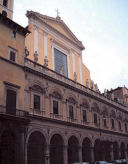
Fourth Sunday of Advent
Station with Ss. XII Apostoli or Santi Dodici Apostoli (Church of the Twelve Holy Apostles):
At Rome, the Station is in the Basilica of the Twelve Apostles, better known in Rome as better known as Santi Apostoli. We receive today a twelve-fold blessing from the apostles with whom we celebrate this last Sunday of Advent. As living stones we are built on these twelve solid and sacred foundation stones who themselves rest on the divine cornerstone, Christ. Ye holy apostles of Christ, be with us and pray for us, that with well-prepared hearts we may "go forth to meet Him, and say: Great is His dominion, and His kingdom will have no end; He is God, the Mighty, the Ruler, the Prince of Peace."
For more on Santi Dodici Apostoli, see:
For further information on the Station Churches, see The Stational Church.


